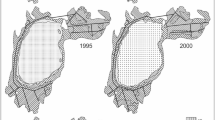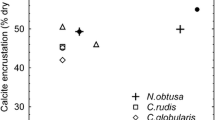Abstract
Two years of measurements are explored with a view to formulating an ecosystem model for Myall Lake. Stable physical characteristics, low catchment loads, low light attenuation, flat-bottomed hypsometry, and soft gyttja substrate allow stable charophyte biomass throughout the year in Myall Lake. Chara fibrosa dominates the total biomass and is abundant over the depth range 0.5–4 m. Nitella hyalina is found over the same depth range but has diminished biomass at depths greater than 2 m due to increased incidence of zero-biomass samples at depths greater than 1.5 m. Upper bounds for biomass densities were estimated for charophytes. Najas marina has great seasonal variability and meadows can have very high biomass in waters 1.5–2.7 m deep. High biomass of Najas marina is associated with low biomass of Nitella hyalina and may be a factor determining how the biomass of Nitella hyalina is distributed with respect to depth. Patchiness of Najas marina is particularly high. Temperature and light can support two growing seasons for Najas marina but mechanical disturbance is often high in spring and high biomass was only observed in late autumn during the present study. Less than 5% of the present-day production of submerged macrophytes would have been required to produce organic material of the gyttja over a 1,000-year period. The spatial distributions of gyttja and the dominant macrophytes are consistent with wind patterns. Down-lake limits on the distributions of charophytes and Najas marina are related to a gradient in the coefficient of light attenuation that is, in turn, related to proximity to the bulk of the catchment load.












Similar content being viewed by others
References
Agami, M., S. Beer, & Y. Waisel, 1980. Growth and photosynthesis of Najas marina L. as affected by light intensity. Aquatic Botany 9: 285–289.
Agami, M., A. Eshel & Y. Waisel, 1984. Najas marina in Israel: Is it a halophyte of glycophyte? Physiologia Plantarum 61: 634–636.
Agami, M. & Y. Waisel, 1983. The effect of temperature and photo-period on growth of Najas marina L. In Den Hartog, C. (ed.), Proceedings, International Symposium on Aquatic Macrophytes, 18–23 September 1983, Faculty of Science, Department of Aquatic Ecology, Nijmegen, The Netherlands: 16–20.
Agami, M. & Y. Waisel, 1984. Germination of Najas marina L. Aquatic Botany 19: 37–44.
Andrews, M., I. R. Davidson, M. E. Andrews & J. A. Raven, 1984. Growth of Chara hispida I. Apical growth and basal decay. Journal of Ecology 72: 873–884.
Asaeda T., L. Rajapakse & B. G. Sanderson, 2007. Morphological and reproductive acclimations to growth of two charophyte species in shallow and deep water. Aquatic Botany 86: 393–401.
Atkinson, G., M. Hutchings, P. Johnson, W. D. Johnson & M. D. Melville, 1981. An ecological investigation of the Myall Lakes region. Australian Journal of Ecology 6: 299–327.
Bachmann R. W., M. V. Hoyer & D. E. Caneld, 2000. Internal heterotrophy following the switch from macrophytes to algae in Lake Apopka, Florida. Hydrobiologia 418: 217–227.
Blindow, I., 1992. Decline of charophytes during eutrophication: Comparison with angiosperms. Freshwater Biology 28: 9–14.
Blindow, I., A. Hargeby & G. Andersson, 2002. Seasonal changes of mechanisms maintaining clear water in a shallow lake with abundant Chara vegetation. Aquatic Botany 72: 315–334.
Casanova, M. T. & M. A. Brock, 1999. Life histories of charophytes from permanent and temporary wetlands in eastern Australia. Australian Journal of Botony 47: 383–397.
Chambers, P. A. & J. Kalff, 1985. Depth distribution and biomass of submerged macrophyte communities in relations to Secchi depth. Canadian Journal of Fisheries and Aquatic Sciences 42: 701–709.
Cohen, D., 2004. An Examination of Planktonic Processes in the Myall Lakes. Honours Thesis, School of Applied Sciences, University of Newcastle, 120 pp.
Crawford, S. A., 1979. Farm pond restoration using Chara vulgaris vegetation. Hydrobiologia 62: 17–31.
Dasey, M., A. Raine, N. Ryan, J. Wilson & N. Cook, 2004. Understanding blue-green algaeblooms in Myall Lakes NSW. New South Wales Department of Infrastructure Planning and Natural Resources, NSW Government, ISBN 0 7347 5498 1
Dasey M., N. Ryan, J. Wilson, G. McGregor, L. Fabbro, B. A. Neilan, B. P. Burns, H. Kankaanp, L. F. Morrison, G. A. Codd, D. Rissik & L. Bowling, 2005. Investigations into the taxonomy, toxicity and ecology of benthic cyanobacterial accumulations in Myall Lake, Australia. Marine and Freshwater Research 56: 45–55.
Fernandez-Alaez, M., C. Fernandez-Alaez & S. Rodriguez, 2002. Seasonal changes in biomass of charophytes in shallow lakes in the northwest of Spain. Aquatic Botany 72: 335–348.
Flynn, K. J., 2005. Castes built on sand: Dysfunctionality in plankton models and the inadequacy of dialogue between biologists and modellers. Journal of Plankton Reseach 27: 1205–1210.
García, A., 1999. Charophyte flora of south-eastern South Australia and south-western Victoria, Australia: Systematics, distribution and ecology. Australian Journal of Botany 47: 407–426.
García, A. & Chivas, A., 2006. Diversity and ecology of extant and Quaternary Australian charophytes (Charales). Cryptogamie Algologie 27: 323–340.
Grant, W. D. & O. S. Madsen, 1979. Combined wave and current interaction with a rough bottom. Journal of Geophysical Research 84(C4): 1797–1808.
Grant, W. D. & O. S. Madsen, 1986. The continental-shelf bottom boundary layer. Annual Review of Fluid Mechanics 18: 265–305.
Hamilton, D. P. & S. F. Mitchell, 1997. Wave-induced shear stress, plant nutrients and chlorophyll in seven shallow lakes. Freshwater Biology 31: 159–168.
Handley, R. J. & A. J. Davy, 2002. Seedling root establishment may limit Najas marina L. to sediments of low cohesive strength. Aquatic Botany 73: 129–136.
Johnson, D. H. 1999. The insignificance of statistical significance testing. Journal of Wildlife Management 63:763–772.
Kufel, L. & I. Kufel, 2002. Chara beds acting as nutrient sinks in shallow lakes—a review. Aquatic Botany 72: 249–260.
Lambeck, K., 1996. Limits on the areal extent of the Barents Sea ice sheet in Late Weischelian time. Global and Planetary Change 12: 41–51.
Lundmark, A., 2004. Zooplankton in a Najas marina bed in Neranie Bay, NSW, Australia. Diel patterns and differences with depths in zooplankton composition and abundance with emphasis on calanoid copepods. Examensarbete (thesis) Spring 2004, Lunds University, Sweden.
Masuda, A., T. Kusaba, K. Marubayashi & M. Ishibashi, 1999. Statistics of wind and waves off Tsuyazaki, Fukuoka, in the Eastern Tsushima Strait. Journal of Oceanography 55: 289–305.
McIntyre, M. E., 2007. On thinking probabilistically. In Extreme Events (Proceedings of the 15th Aha Hulikoa Workshop), SOEST, Unuiversity of Hawaii, 153–161.
Middelboe, A. L. & S. Markager, 1997. Depth limits and minimum light requirements of freshwater macrophytes. Freshwater Biology 37: 553–568.
Noges, P., L. Tuvikene, T. Feldmann, I. Tonno, H. Kunnap, H. Luup, J. Salujoe & T. Noges, 2003. The role of charophytes in increasing water transparency: A case study of two shallow lakes in Estonia. Shallow Lakes 2002. Hydrobiologia 506–509: 567–573
Noordhuis, R., D. T. van der Molen & M. S. van den Berg, 2002. Response of herbivorous water-birds to the return of Chara in in Lake Veluwemeer, The Netherlands. Aquatic Botany 72: 349–367.
Sanderson, B. G., 2008. Circulation and the nutrient budget in Myall Lakes. Hydrobiolgia. doi:10.1007/s10750-008-9380-6
Schallenberg, M. & C. W. Burns, 2003. A temperate, tidal lake-wetland complex 2. Water quality and implications for zooplankton community structure. New Zealand Journal of Marine and Freshwater Research 37: 429–447.
Schutten, J., J. Dainty & A. J. Davy, 2004. Wave-induced hydraulic forces on submerged aquatic plants in shallow lakes. Annals of Botany 93: 333–341.
Schutten, J., J. Dainty & A. J. Davy, 2005. Root anchorage and its significance for submerged plants in shallow lakes. Journal of Ecology 93: 556–571.
Schwarz, A. M., M. de Winton & I. Hawes, 2002. Species-specific depth zonation in new Zealand charophytes as a function of light availability. Aquatic Botany 72: 209–217.
Shilla, D., T. Asaeda, T. Fujino & B. G. Sanderson, 2006. Decomposition of dominant submerged macrophytes: Implications for nutrient release in Myall Lake, NSW, Australia. Wetlands Ecology and Management 14: 427–433.
Skilbeck, G. C., T. C. Rolph, N. Hill, J. Woods & R. H. Wilkens, 2005. Holocene millennial/centennial-scale multiproxy cyclicity in temperate eastern Australian estuary sediments. Journal of Quaternary Science 20: 327–347.
Spence, D. H. N., 1982. The zonation of plants in freshwater lakes. Advances in Ecological Research 12: 37–125.
Squires, M. M. & L. F. W. Lesack, 2003. The relation between sediment nutrient content and macrophyte biomass and community structure along a water transparency gradient among lakes of the Mackenzie Delta. Canadian Journal of Fisheries and Aquatic Sciences 60: 333–343.
Stross, R. G., 1979. Density and boundary regulations of the Nitella meadows in Lake George, New York. Aquatic Botany 6: 285–300.
Tracy, M., J. M. Montante, T. E. Allenson & R. A. Hough, 2003. Long-term responses of aquatic macrophyte diversity and community structure to variation in nitrogen loading. Aquatic Botany 77: 43–52.
Van Donk, E. & W. J. Van de Bund, 2001. Impact of submerged macrophytes including charophytes on phyto- and zooplankton communities: Allelopathy versus other mechanisms. Aquatic Botany 72: 261–274.
Webster, I. T. & G. P. Harris 2004. Anthropogenic impacts on the ecosystems of coastal lagoons: Modelling fundamental biogeochemical processes and management implications. Marine and Freshwater Research 55: 67–78.
Westoby, M., 1984. The self-thinning rule. Advances in Ecological Research 14: 167–255.
Zaneveld, J. S., 1940. The charophyta of Malaysia and adjacent countries. Blumea 4: 1–223.
Acknowledgements
We thank Mr. Brendan Haines, Mr. Max Carpenter, Dr. Kian Siong, Dr. Takeshi Fujino, Dr. Jagath Manatunga, and Dr. Daniel Shilla for help in the field. Wind measurements were provided by the Bureau of Meteorology and water level measurements by Manly Hydraulics Laboratory. Dr. Joanne Wilson and Ms. Samantha Wellman kindly shared time series of light measurements. Special thanks are extended to Dr. Adriana García for indentifying the charophyte species. Substantive comments by Dr. Adriana García and two anonymous reviewers guided us towards a more logically complete analysis and improved presentation.
Author information
Authors and Affiliations
Corresponding author
Additional information
Guest editors: J. Wilson, L. Bowling & J. Tibby
The Myall Lakes: patterns and processes in an unusual coastal lake system in eastern Australia
Rights and permissions
About this article
Cite this article
Sanderson, B.G., Asaeda, T., Rajapakse, L. et al. Mechanisms affecting biomass and distribution of charophytes and Najas marina in Myall Lake, New South Wales, Australia. Hydrobiologia 608, 99–119 (2008). https://doi.org/10.1007/s10750-008-9373-5
Published:
Issue Date:
DOI: https://doi.org/10.1007/s10750-008-9373-5




